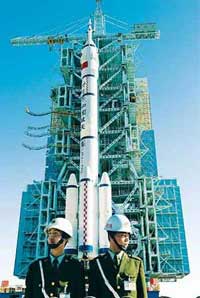|
Observation centre ready for space mission
By Ma Lie (China Daily/AFP)
Updated: 2005-10-11 05:57
China to launch Shenzhou VI Oct 12-15
China will launch its second manned space mission between October 12 and 15,
an aerospace official said Tuesday.

Shenzhou VI, a
spaceship to carry two astronauts into orbit, sits atop of the LM-2F
carrier rocket at the launching pad in Jiuquan satellite launch center in
northwest China October 7, 2005. It is widely reported that China's second
manned spaceship will be launched on October 13. [Nanfang
Daily] | The Shenzhou VI aircraft will carry two
astronauts into the sky from the Jiuquan Satellite Launch Center, the Xinhua
News Agency quoted the official with the headquarters for China's manned space
mission as saying.
The craft is expected to land at a location in central Inner Mongolia
Autonomous Region, the official said, adding that the preparations for the
launch are going smoothly.
AFP Monday quoted an anonymous official from the technical department of the
Jiuquan Satellite Launch Center as saying that "It (launch time) is October
12 at 9 am."
A travel agent taking domestic tourists to witness the launch said he had
been advised to be at the site early Wednesday morning.
The six astronauts shortlisted for the two-member mission have arrived at the
launch pad in Inner Mongolia and Zhai Zhigang and Nie Haisheng are favorites to
pilot the mission, reports said.
No plant seeds on Shenzhou VI
Shenzhou VI will not carry any plant seeds, Liu Luxiang, director of the
Centre for Space Breeding under the Beijing-based Chinese Academy of
Agricultural Sciences.
The announcement came after media reports speculated that the spacecraft
would carry seeds, animal semen or other experimental items for space mutation
breeding.
"Since Shenzhou V, which took the first Chinese astronaut Yang Liwei 14 times
around the earth for a 21-hour period in 2003, space experiments in China have
been focusing on human activities in outer space," said Liu.
The second manned space mission will carry two astronauts into orbit for five
days, during which their physical reactions will be closely monitored.
"If it were an unmanned spaceship or recoverable satellite, we might have put
experimental things on it," said Liu, whose department selects seeds for outer
space experimentation and allocates them to breeding nurseries after they are
brought back.
"An unmanned spaceship and a recoverable satellite could have a relatively
looser security demand and could expose seeds to more cosmic radiation to cause
a useful mutation," he said.
"But as a manned capsule, the Shenzhou VI has a different structure to block
radiation as much as possible, and strict measures are being taken to ensure its
security."
Liu had obtained evidence from other sources but refused to identify them,
saying only: "China's style is to focus on one thing at a time."
He also denied that the absence of seeds is due to limited space on the
capsule.
Since 1987, China has been keen on sending plant seeds about 200 to 400
kilometres above the earth to study genetic mutations and changes.
A variety of seeds, including corn, lotus and watermelon, have travelled in
space for up to two weeks in recoverable satellites or high-altitude balloons.
The high radiation in space-mutated, or genetically-modified, seeds' DNA, may
explain why peonies grown from "space seeds" are larger and more colourful than
normal. The mutations may also explain jumbo bell peppers and fast-growing rice.
In the past five years, the Centre for Space Breeding developed 12 rice and
wheat variants that greatly increased grain output, according to a statement
released last month by the centre.
|